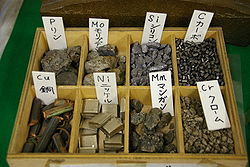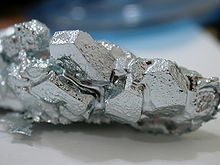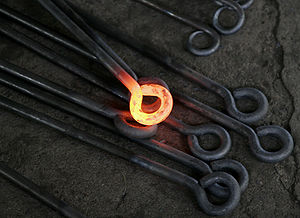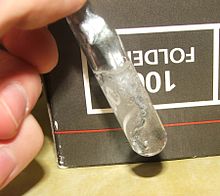- Metal
-
A metal (from Greek "μέταλλον" – métallon, "mine, quarry,"[1] from Greek μετ' ἄλλα = "in search of other things"; compare wikt:meta- and wikt:allo-), is an element, compound, or alloy that is a good conductor of both electricity and heat. Metals are usually malleable and shiny, that is they reflect most of incident light.[2] In a metal, atoms readily lose electrons to form positive ions (cations). Those ions are surrounded by delocalized electrons, which are responsible for the conductivity. The solid thus produced is held by electrostatic interactions between the ions and the electron cloud, which are called metallic bonds.[3]
Contents
Definition
Metals are sometimes described as an arrangement of positive ions surrounded by a sea of delocalized electrons. Metals occupy the bulk of the periodic table, while non-metallic elements can only be found on its right-hand side. A diagonal line, drawn from boron (B) to polonium (Po), separates the metals from the nonmetals. Most elements on this line are metalloids, sometimes called semiconductors. This is because these elements exhibit electrical properties common to both conductors and insulators. Elements to the lower left of this division line are called metals, while elements to the upper right of the division line are called nonmetals.
An alternative definition of metal refers to the band theory. If one fills the energy bands of a material with available electrons and ends up with a top band partly filled then the material is a metal. This definition opens up the category for metallic polymers and other organic metals. These synthetic materials often have the characteristic silvery gray reflectiveness (luster) of elemental metals.
Astronomy
In the specialized usage of astronomy and astrophysics, the term "metal" is often used to refer collectively to all elements other than hydrogen or helium, including substances as chemically non-metallic as neon, fluorine, and oxygen. Nearly all the hydrogen and helium in the Universe was created in Big Bang nucleosynthesis, whereas all the "metals" were produced by nucleosynthesis in stars or supernovae. The Sun and the Milky Way Galaxy are composed of roughly 74% hydrogen, 24% helium, and 2% "metals" (the rest of the elements; atomic numbers 3–118) by mass.[4]
The concept of a metal in the usual chemical sense is irrelevant in stars, as the chemical bonds that give elements their properties cannot exist at stellar temperatures.
Properties
Chemical
Metals are usually inclined to form cations through electron loss,[3] reacting with oxygen in the air to form oxides over changing timescales (iron rusts over years, while potassium burns in seconds). Examples:
- 4 Na + O2 → 2 Na2O (sodium oxide)
- 2 Ca + O2 → 2 CaO (calcium oxide)
- 4 Al + 3 O2 → 2 Al2O3 (aluminium oxide).
The transition metals (such as iron, copper, zinc, and nickel) take much longer to oxidize. Others, like palladium, platinum and gold, do not react with the atmosphere at all. Some metals form a barrier layer of oxide on their surface which cannot be penetrated by further oxygen molecules and thus retain their shiny appearance and good conductivity for many decades (like aluminium, magnesium, some steels, and titanium). The oxides of metals are generally basic, as opposed to those of nonmetals, which are acidic.
Painting, anodizing or plating metals are good ways to prevent their corrosion. However, a more reactive metal in the electrochemical series must be chosen for coating, especially when chipping of the coating is expected. Water and the two metals form an electrochemical cell, and if the coating is less reactive than the coatee, the coating actually promotes corrosion.
Physical
Metals in general have high electrical conductivity which depends on their valency of ions, thermal conductivity, luster and density, and the ability to be deformed under stress without cleaving.[3] While there are several metals that have low density, hardness, and melting points, these (the alkali and alkaline earth metals) are extremely reactive, and are rarely encountered in their elemental, metallic form. Optically speaking, metals are opaque, shiny and lustrous. This is because visible lightwaves are not readily transmitted through the bulk of their microstructure. The large number of mobile electrons in any typical metallic solid (element or alloy) is responsible for the fact that they can never be categorized as transparent materials.
The majority of metals have higher densities than the majority of nonmetals.[3] Nonetheless, there is wide variation in the densities of metals; lithium is the least dense solid element and osmium is the densest. The metals of groups I A and II A are referred to as the light metals because they are exceptions to this generalization.[3] The high density of most metals is due to the tightly packed crystal lattice of the metallic structure. The strength of metallic bonds for different metals reaches a maximum around the center of the transition metal series, as those elements have large amounts of delocalized electrons in tight binding type metallic bonds. However, other factors (such as atomic radius, nuclear charge, number of bonding orbitals, overlap of orbital energies, and crystal form) are involved as well.[3]. Most non-ferrous metals can be recycled many times during their life cycle.
Electrical
The electrical and thermal conductivity of metals originate from the fact that in the metallic bond, the outer electrons of the metal atoms form a gas of nearly free electrons, moving as an electron gas in a background of positive charge formed by the ion cores. Good mathematical predictions for electrical conductivity, as well as the electrons' contribution to the heat capacity and heat conductivity of metals can be calculated from the free electron model, which does not take the detailed structure of the ion lattice into account.
When considering the exact band structure and binding energy of a metal, it is necessary to take into account the positive potential caused by the specific arrangement of the ion cores – which is periodic in crystals. The most important consequence of the periodic potential is the formation of a small band gap at the boundary of the Brillouin zone. Mathematically, the potential of the ion cores can be treated by various models, the simplest being the nearly free electron model.
Mechanical
Mechanical properties of metals include ductility, which is largely due to their inherent capacity for plastic deformation. Reversible elasticity in metals can be described by Hooke's Law for restoring forces, where the stress is linearly proportional to the strain. Forces larger than the elastic limit, or heat, may cause a permanent (irreversible) deformation of the object, known as plastic deformation or plasticity. This irreversible change in atomic arrangement may occur as a result of:
- The action of an applied force (or work). An applied force may be tensile (pulling) force, compressive (pushing) force, shear, bending or torsion (twisting) forces.
- A change in temperature (or heat). A temperature change may affect the mobility of the structural defects such as grain boundaries, point vacancies, line and screw dislocations, stacking faults and twins in both crystalline and non-crystalline solids. The movement or displacement of such mobile defects is thermally activated, and thus limited by the rate of atomic diffusion.
Viscous flow near grain boundaries, for example, can give rise to internal slip, creep and fatigue in metals. It can also contribute to significant changes in the microstructure like grain growth and localized densification due to the elimination of intergranular porosity. Screw dislocations may slip in the direction of any lattice plane containing the dislocation, while the principal driving force for "dislocation climb" is the movement or diffusion of vacancies through a crystal lattice.
In addition, the nondirectional nature of metallic bonding is also thought to contribute significantly to the ductility of most metallic solids. When the planes of an ionic bond slide past one another, the resultant change in location shifts ions of the same charge into close proximity, resulting in the cleavage of the crystal; such shift is not observed in covalently bonded crystals where fracture and crystal fragmentation occurs.[5]
Alloys
An alloy is a mixture of two or more elements in solid solution in which the major component is a metal. Most pure metals are either too soft, brittle or chemically reactive for practical use. Combining different ratios of metals as alloys modifies the properties of pure metals to produce desirable characteristics. The aim of making alloys is generally to make them less brittle, harder, resistant to corrosion, or have a more desirable color and luster. Of all the metallic alloys in use today, the alloys of iron (steel, stainless steel, cast iron, tool steel, alloy steel) make up the largest proportion both by quantity and commercial value. Iron alloyed with various proportions of carbon gives low, mid and high carbon steels, with increasing carbon levels reducing ductility and toughness. The addition of silicon will produce cast irons, while the addition of chromium, nickel and molybdenum to carbon steels (more than 10%) results in stainless steels.
Other significant metallic alloys are those of aluminium, titanium, copper and magnesium. Copper alloys have been known since prehistory—bronze gave the Bronze Age its name—and have many applications today, most importantly in electrical wiring. The alloys of the other three metals have been developed relatively recently; due to their chemical reactivity they require electrolytic extraction processes. The alloys of aluminium, titanium and magnesium are valued for their high strength-to-weight ratios; magnesium can also provide electromagnetic shielding[citation needed]. These materials are ideal for situations where high strength-to-weight ratio is more important than material cost, such as in aerospace and some automotive applications.
Alloys specially designed for highly demanding applications, such as jet engines, may contain more than ten elements.
Categories
Base metal
In chemistry, the term base metal is used informally to refer to a metal that oxidizes or corrodes relatively easily, and reacts variably with dilute hydrochloric acid (HCl) to form hydrogen. Examples include iron, nickel, lead and zinc. Copper is considered a base metal as it oxidizes relatively easily, although it does not react with HCl. It is commonly used in opposition to noble metal.
In alchemy, a base metal was a common and inexpensive metal, as opposed to precious metals, mainly gold and silver. A longtime goal of the alchemists was the transmutation of base metals into precious metals.
In numismatics, coins used to derive their value primarily from the precious metal content. Most modern currencies are fiat currency, allowing the coins to be made of base metal.
Ferrous metal
Main article: Ferrous and non-ferrous metalsThe term "ferrous" is derived from the Latin word meaning "containing iron". This can include pure iron, such as wrought iron, or an alloy such as steel. Ferrous metals are often magnetic, but not exclusively.
Noble metal
Noble metals are metals that are resistant to corrosion or oxidation, unlike most base metals. They tend to be precious metals, often due to perceived rarity. Examples include tantalum, gold, platinum, silver and rhodium.
Precious metal
A precious metal is a rare metallic chemical element of high economic value.
Chemically, the precious metals are less reactive than most elements, have high luster and high electrical conductivity. Historically, precious metals were important as currency, but are now regarded mainly as investment and industrial commodities. Gold, silver, platinum and palladium each have an ISO 4217 currency code. The best-known precious metals are gold and silver. While both have industrial uses, they are better known for their uses in art, jewelry, and coinage. Other precious metals include the platinum group metals: ruthenium, rhodium, palladium, osmium, iridium, and platinum, of which platinum is the most widely traded.
The demand for precious metals is driven not only by their practical use, but also by their role as investments and a store of value. Palladium was, as of summer 2006, valued at a little under half the price of gold, and platinum at around twice that of gold. Silver is substantially less expensive than these metals, but is often traditionally considered a precious metal for its role in coinage and jewelry.
Extraction
Metals are often extracted from the Earth by means of mining, resulting in ores that are relatively rich sources of the requisite elements. Ore is located by prospecting techniques, followed by the exploration and examination of deposits. Mineral sources are generally divided into surface mines, which are mined by excavation using heavy equipment, and subsurface mines.
Once the ore is mined, the metals must be extracted, usually by chemical or electrolytic reduction. Pyrometallurgy uses high temperatures to convert ore into raw metals, while hydrometallurgy employs aqueous chemistry for the same purpose. The methods used depend on the metal and their contaminants.
When a metal ore is an ionic compound of that metal and a non-metal, the ore must usually be smelted — heated with a reducing agent — to extract the pure metal. Many common metals, such as iron, are smelted using carbon as a reducing agent. Some metals, such as aluminium and sodium, have no commercially practical reducing agent, and are extracted using electrolysis instead.[6][7]
Sulfide ores are not reduced directly to the metal but are roasted in air to convert them to oxides.
Recycling of metals
Demand for metals is closely linked to economic growth. During the 20th century, the variety of metals uses in society grew rapidly. Today, the development of major nations, such as China and India, and advances in technologies, are fuelling ever more demand. The result is that mining activities are expanding, and more and more of the world’s metal stocks are above ground in use, rather than below ground as unused reserves. An example is the in-use stock of copper. Between 1932 and 1999, copper in use in the USA rose from 73g to 238g per person.[8]
Metals are inherently recyclable, so in principle, can be used over and over again, minimizing these negative environmental impacts and saving energy at the same time. For example, 95% of the energy used to make aluminium from bauxite ore is saved by using recycled material.[9] However, levels of metals recycling are generally low. In 2010, the International Resource Panel, hosted by the United Nations Environment Programme (UNEP) published reports on metal stocks that exist within society[10] and their recycling rates.[11]
The report authors observed that the metal stocks in society can serve as huge mines above ground. However, they warned that the recycling rates of some rare metals used in applications such as mobile phones, battery packs for hybrid cars and fuel cells, are so low that unless future end-of-life recycling rates are dramatically stepped up these critical metals will become unavailable for use in modern technology.
Metallurgy
Metallurgy is a domain of materials science that studies the physical and chemical behavior of metallic elements, their intermetallic compounds, and their mixtures, which are called alloys.
Applications
Some metals and metal alloys possess high structural strength per unit mass, making them useful materials for carrying large loads or resisting impact damage. Metal alloys can be engineered to have high resistance to shear, torque and deformation. However the same metal can also be vulnerable to fatigue damage through repeated use or from sudden stress failure when a load capacity is exceeded. The strength and resilience of metals has led to their frequent use in high-rise building and bridge construction, as well as most vehicles, many appliances, tools, pipes, non-illuminated signs and railroad tracks.
The two most commonly used structural metals, iron and aluminium, are also the most abundant metals in the Earth's crust.[12]
Metals are good conductors, making them valuable in electrical appliances and for carrying an electric current over a distance with little energy lost. Electrical power grids rely on metal cables to distribute electricity. Home electrical systems, for the most part, are wired with copper wire for its good conducting properties.
The thermal conductivity of metal is useful for containers to heat materials over a flame. Metal is also used for heat sinks to protect sensitive equipment from overheating.
The high reflectivity of some metals is important in the construction of mirrors, including precision astronomical instruments. This last property can also make metallic jewelry aesthetically appealing.
Some metals have specialized uses; radioactive metals such as uranium and plutonium are used in nuclear power plants to produce energy via nuclear fission. Mercury is a liquid at room temperature and is used in switches to complete a circuit when it flows over the switch contacts. Shape memory alloy is used for applications such as pipes, fasteners and vascular stents.
Trade
The World Bank reports that China was the top importer of ores and metals in 2005 followed by the U.S.A. and Japan.[13]
See also
References
- ^ μέταλλον Henry George Liddell, Robert Scott, A Greek-English Lexicon, on Perseus Digital Library
- ^ metal. Encyclopedica Britannica
- ^ a b c d e f Mortimer, Charles E. (1975). Chemistry: A Conceptual Approach (3rd ed.). New York:: D. Van Nostrad Company.
- ^ Sparke, Linda S.; Gallagher, John S. (2000). Galaxies in the Universe (1 ed.). Cambridge University Press. p. 8. ISBN 0521592410.
- ^ Ductility – strength of materials
- ^ "Los Alamos National Laboratory – Sodium". http://periodic.lanl.gov/11.shtml. Retrieved 2007-06-08.
- ^ "Los Alamos National Laboratory – Aluminum". http://periodic.lanl.gov/13.shtml. Retrieved 2007-06-08.
- ^ The Recycling Rates of Metals: A Status Report 2010, International Resource Panel, United Nations Environment Programme
- ^ Tread lightly: Aluminium attack Carolyn Fry, Guardian.co.uk, 22 February 2008.
- ^ Metal Stocks in Society: Scientific Synthesis 2010, International Resource Panel, United Nations Environment Programme
- ^ The Recycling Rates of Metals: A Status Report 2010, International Resource Panel, United Nations Environment Programme
- ^ Frank Kreith and Yogi Goswami, eds. (2004). The CRC Handbook of Mechanical Engineering, 2nd edition. Boca Raton. p. 12-2.
- ^ Structure of merchandise imports
Periodic tables Layouts - Standard
- Large table
- Inline f-block
- Vertical
- Text only
- Metals and nonmetals
- Blocks
- Valences
- Extension beyond the 7th period
- Large extended table
- Electron configurations
- Electronegativities
- Alternatives
- Crystal structure
- Discovery periods
List of elements by - Name etymology (symbol)
- Discovery
- Oxidation state
- Abundance (in humans)
- Nuclear stability
- Hardness
- Atomic properties
- Production
Groups Other element categories - Periods
- Metals
- Transition metals
- Metalloids
- Nonmetals
- Lanthanides
- Actinides
- Rare earth elements
- Platinum group metals (PGMs)
- Post-transition metals
- Refractory metals
Blocks Periods Periodic table H He Li Be B C N O F Ne Na Mg Al Si P S Cl Ar K Ca Sc Ti V Cr Mn Fe Co Ni Cu Zn Ga Ge As Se Br Kr Rb Sr Y Zr Nb Mo Tc Ru Rh Pd Ag Cd In Sn Sb Te I Xe Cs Ba La Ce Pr Nd Pm Sm Eu Gd Tb Dy Ho Er Tm Yb Lu Hf Ta W Re Os Ir Pt Au Hg Tl Pb Bi Po At Rn Fr Ra Ac Th Pa U Np Pu Am Cm Bk Cf Es Fm Md No Lr Rf Db Sg Bh Hs Mt Ds Rg Cn Uut Uuq Uup Uuh Uus Uuo Alkali metals Alkaline earth metals Lanthanides Actinides Transition metals Other metals Metalloids Other nonmetals Halogens Noble gases Unknown chem. properties Large version Categories:- Metallic elements
- Metals
- Metalworking
- Numismatics
- Greek loanwords
Wikimedia Foundation. 2010.






